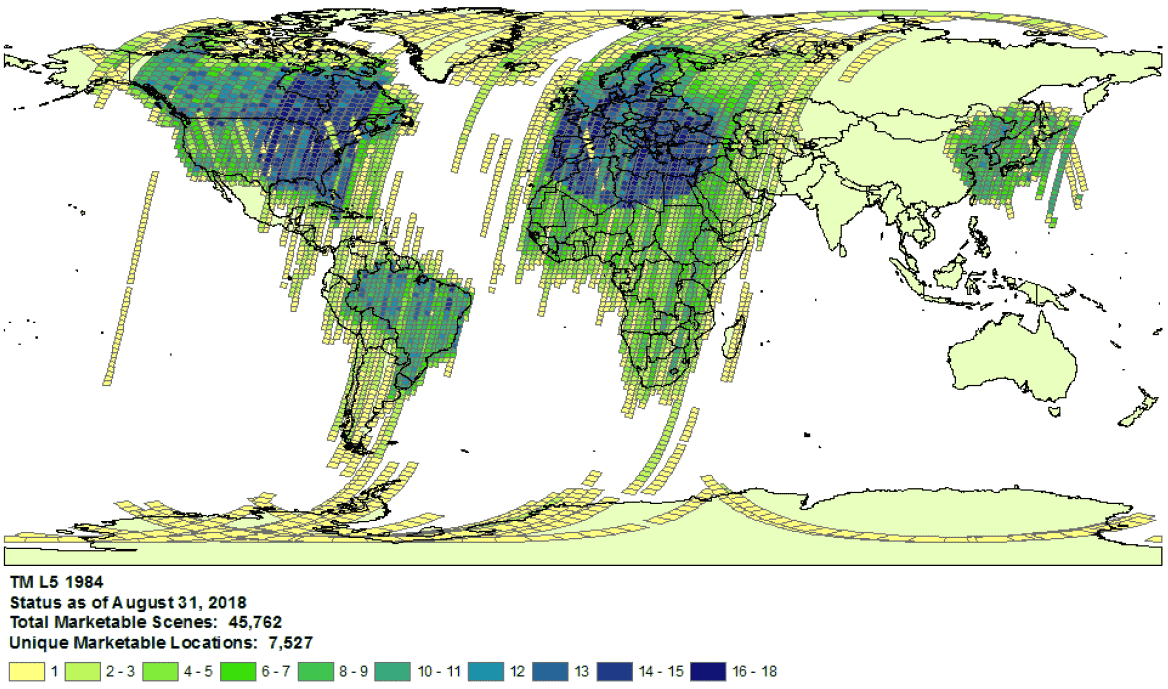เอกสารนี้มีไว้เพื่อช่วยคุณระบุว่ามีชิ้นงานขาดหายไปหรือไม่ในแคตตาล็อกข้อมูล Earth Engine (ปัจจุบันคือ Landsat, Sentinel และ MODIS)
ขั้นตอนที่ระบุไว้จะอธิบายวิธีดำเนินการต่อไปนี้
ตรวจสอบชิ้นงานที่พร้อมใช้งานในแคตตาล็อกของ Earth Engine และผู้ให้บริการ
รวบรวมข้อมูลที่จําเป็นในการส่งการยืนยันชิ้นงานที่หายไปไปยังทีมข้อมูล Earth Engine
สิ่งที่ควรพิจารณาโดยทั่วไป
ระดับการประมวลผล: รูปภาพบางรูปอาจไม่พร้อมใช้งานสำหรับระดับการประมวลผลหรือผลิตภัณฑ์หนึ่งๆ เช่น ระบบอาจไม่ประมวลผลรูปภาพคุณภาพต่ำเป็นระดับสูงสุด
ความครอบคลุมเชิงพื้นที่และเวลา: ไม่มีการรับประกันความถี่ที่แน่นอนสำหรับชุดข้อมูลแต่ละชุด ความแตกต่างของงานเซ็นเซอร์ คุณภาพของรูปภาพ และการจัดการที่เก็บถาวรอาจส่งผลต่อความพร้อมใช้งานของข้อมูลผู้ให้บริการ
 ตัวอย่างความครอบคลุมของชุดข้อมูล Landsat 5 เมื่อปี 1984
ตัวอย่างความครอบคลุมของชุดข้อมูล Landsat 5 เมื่อปี 1984
- ตัวเลือกผู้ให้บริการ: ระบบจะนำเข้าข้อมูลจากผู้ให้บริการที่เลือกไว้ในแต่ละชุดข้อมูลไปยังแคตตาล็อกข้อมูล Earth Engine เป็นไปได้ว่าผู้ให้บริการอาจไม่มีบันทึกภารกิจที่สมบูรณ์ ตัวอย่างเช่น ระบบจะนำเข้าชุดข้อมูล Landsat จากที่เก็บถาวรของ USGS ซึ่งทราบว่าไม่มีภาพจากสถานีรับสัญญาณบางแห่งเป็นระยะเวลาหนึ่ง (ดูข้อมูลเพิ่มเติมจากความพยายามของ LGAC)
Landsat
ระบบจะนำเข้าข้อมูลจาก กรมสำรวจธรณีวิทยาของสหรัฐอเมริกา (USGS)
ตรวจสอบความพร้อมให้บริการของภาพ Landsat สำหรับเวลาและพื้นที่ที่ต้องการ
ทำการค้นหาใน Earth Engine เพื่อดูรายการชิ้นงานทั้งหมดสำหรับเวลาและพื้นที่ที่ต้องการ โปรดตรวจสอบว่าไม่มีชิ้นงานที่กรองออกโดยไม่ตั้งใจภายในโค้ด สคริปต์ตัวอย่างมีดังนี้ ตรวจสอบว่าคุณกำลังนำเข้าคอลเล็กชันที่มีระดับและการประมวลผลที่เหมาะสม (ดูข้อมูลเพิ่มเติมเกี่ยวกับโครงสร้างคอลเล็กชัน Landsat)
มองหาชิ้นงานที่อาจหายไปในแคตตาล็อก USGS Earth Explorer (ดูคำแนะนำในความช่วยเหลือเพื่อดูขั้นตอนโดยละเอียดเกี่ยวกับการค้นหาและการเลือกชุดข้อมูล) ตรวจสอบว่าคุณกำลังเปรียบเทียบผลิตภัณฑ์และระดับการประมวลผลที่ถูกต้อง (ดูโครงสร้างคอลเล็กชัน Landsat) โปรดทราบว่าระบบจะสร้างผลิตภัณฑ์การสะท้อนแสงของพื้นผิวสำหรับภาพ Landsat ที่มีระดับการประมวลผลเป็น L1TP เท่านั้น
แชร์หลักฐานโดยละเอียดเกี่ยวกับชิ้นงานที่หายไปโดยส่งคำขอแจ้งปัญหาพร้อมรหัสผลิตภัณฑ์ของผู้ให้บริการและลิงก์ไปยังสคริปต์เครื่องมือแก้ไขโค้ดของ Earth Engine ที่ยืนยันว่าไม่มีชิ้นงาน
Sentinel
ระบบจะนำเข้าข้อมูลจาก Sentinel จากเว็บไซต์ Copernicus Dataspace
ตรวจสอบความพร้อมให้บริการของ Sentinel สำหรับช่วงเวลาและพื้นที่ที่ต้องการ (ดูรายละเอียดภารกิจ)
หมายเหตุ: ผลิตภัณฑ์ Sentinel-2 ระดับ 2A สร้างขึ้นอย่างเป็นระบบที่ภาคพื้นดินในยุโรปตั้งแต่เดือนมีนาคม 2018 เท่านั้น และขยายการผลิตไปยังทั่วโลกในเดือนธันวาคม 2018 (ดูรายละเอียดเพิ่มเติมได้ที่คู่มือผู้ใช้ ESA) รายการเหล่านี้จะสร้างขึ้นใหม่โดยเป็นส่วนหนึ่งของคอลเล็กชัน 1 ในท้ายที่สุด
ทำการค้นหาใน Earth Engine เพื่อดูรายการชิ้นงานทั้งหมดสำหรับเวลาและพื้นที่ที่ต้องการ โปรดตรวจสอบว่าไม่มีชิ้นงานที่กรองออกโดยไม่ตั้งใจภายในโค้ด ต่อไปนี้เป็นตัวอย่างสคริปต์ โปรดตรวจสอบว่าคุณนําเข้าคอลเล็กชันด้วยระดับการประมวลผลที่ถูกต้อง
มองหาเนื้อหาที่อาจหายไปในแคตตาล็อก Copernicus
แชร์หลักฐานโดยละเอียดเกี่ยวกับชิ้นงานที่หายไปโดยส่งคำขอแจ้งปัญหาพร้อมรหัสผลิตภัณฑ์ของผู้ให้บริการและลิงก์ไปยังสคริปต์เครื่องมือแก้ไขโค้ดของ Earth Engine ที่ยืนยันว่าไม่มีชิ้นงาน
MODIS
ระบบจะนำเข้าข้อมูลจาก Land Processes Distributed Active Archive Center (LP DAAC)
ทำการค้นหาใน Earth Engine เพื่อดูรายการชิ้นงานทั้งหมดสำหรับเวลาและพื้นที่ที่ต้องการ โปรดตรวจสอบว่าไม่มีชิ้นงานที่กรองออกโดยไม่ตั้งใจภายในโค้ด ต่อไปนี้คือตัวอย่างสคริปต์ โปรดตรวจสอบว่าคุณกำลังนำเข้าผลิตภัณฑ์ที่ต้องการ
มองหาชิ้นงานที่อาจหายไปในกลุ่มข้อมูล USGS ซึ่งยังไม่ได้เพิ่มลงใน Earth Engine ไปที่โฟลเดอร์ที่เหมาะสมและระบุไดเรกทอรีล่าสุดที่ใช้ได้
ชุดข้อมูลขึ้นต้นด้วย "MOD" อยู่ใน "Terra MODIS"
ชุดข้อมูลขึ้นต้นด้วย "MYD" อยู่ใน "Aqua MODIS"
ชุดข้อมูลที่ขึ้นต้นด้วย "MCD" อยู่ใน "MODIS รวม"
ชุดข้อมูลที่ขึ้นต้นด้วย "VNP" อยู่ใน "S-NPP VIIRS"
แชร์หลักฐานโดยละเอียดเกี่ยวกับชิ้นงานที่หายไปโดยส่งคำขอแจ้งปัญหาพร้อมรหัสผลิตภัณฑ์ของผู้ให้บริการและลิงก์ไปยังสคริปต์เครื่องมือแก้ไขโค้ดของ Earth Engine ที่ยืนยันว่าไม่มีชิ้นงาน
